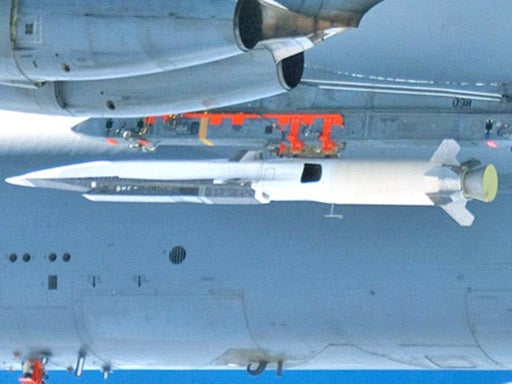US loses its 3,600mph hypersonic X-51A Waverider jet

Your support helps us to tell the story
From reproductive rights to climate change to Big Tech, The Independent is on the ground when the story is developing. Whether it's investigating the financials of Elon Musk's pro-Trump PAC or producing our latest documentary, 'The A Word', which shines a light on the American women fighting for reproductive rights, we know how important it is to parse out the facts from the messaging.
At such a critical moment in US history, we need reporters on the ground. Your donation allows us to keep sending journalists to speak to both sides of the story.
The Independent is trusted by Americans across the entire political spectrum. And unlike many other quality news outlets, we choose not to lock Americans out of our reporting and analysis with paywalls. We believe quality journalism should be available to everyone, paid for by those who can afford it.
Your support makes all the difference.An unmanned hypersonic jet failed and broke up seconds into a test flight yesterday in the latest setback to hit one of the US military's most cutting-edge engineering projects, which could now be under threat.
The X-51A Waverider was designed to hit speeds of up to 3,600mph, six-times the speeds of sound, for a period of five minutes after being dropped from a B-52 bomber during a high-altitude flight.
The craft was successfully launched from its mothership during its test-flight on Tuesday, its development team disclosed yesterday, and everything seemed to be fine initially when its rocket booster engaged, firing it away at rapid speed. But a faulty control fin meant the prototype’s main engine – the revolutionary but still largely untested supersonic-combustion ramjet, or “scramjet” as it is known – was unable to start.
Controllers realised they had a problem just 16 seconds after the Waverider’s rocket booster engaged. When it detached 15 seconds later, the machine quickly lost control and disintegrated, sending the remains crashed into an area of the Pacific Ocean north-west of Los Angeles at Point Mugu.
"It is unfortunate that a problem with this sub-system caused a termination before we could light the scramjet engine," said Charlie Brink from the Air Force Research Laboratory at the Wright-Patterson Air Force Base in Ohio. "All our data showed we had created the right conditions for engine ignition and we were very hopeful to meet our test objectives.”
Hopes had been high for the project, which has been looking into the possibility of developing technologies allowing the US Air Force to launch ultrafast strikes on enemy targets – as well as allowing a potential successor to Concorde to fly from London to New York in just one hour.
The first test flight of the experimental jet in 2010 was largely successful, with the Waverider reaching a velocity of five-times the speed of sound for three minutes. A problem with the rocket booster not separating from the main craft sent the second trial falling into the sea last year, however.
Reports said that the control subsystem which was at fault in the latest trial had previously proved to be reliable.
With only four of the X-51A vehicles having been built, it is unclear when or if the final model will be used.
Join our commenting forum
Join thought-provoking conversations, follow other Independent readers and see their replies
Comments